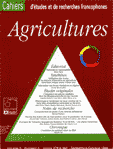Comportement de ponte de "Godasa sidae", chenille défoliatrice de "Mansonia altissima"
Résumé
The present paper investigates the oviposition sites, characteristics of eggs laid and their distribution within the tree crown from the viewpoint of population dynamics. Godasa sidae deposits its eggs in clusters on the undersides of young Mansonia altissima leaves, the only substrates on which eggs were observed in the field. Most clusters contained between 51 and 250 eggs, the observed mean being 206. Of the 17,581 eggs examined, 1,494 appeared to be sterile; most of these were laid singly on older leaves or belonged to clusters of less than 10. In the field, the fertility rate was thus very high (91.5%). The distribution of clusters within the tree crown decreased from top to bottom of the cyme, while the tips of branches seemed to be the most suitable site for oviposition. The presence of M. altissima leaves, host plant to G. sidae, significantly increased the females' egg-laying capacity. However, this effect was only observed when the females had already mated. In the absence of mating, few eggs were laid. The present observations may prove of great use in insect population sampling.Publié
1994-09-01
Comment citer
Foahom, B. (1994). Comportement de ponte de "Godasa sidae", chenille défoliatrice de "Mansonia altissima". Cahiers Agricultures, 3(5), 315–317 (1). Consulté à l’adresse https://revues.cirad.fr/index.php/cahiers-agricultures/article/view/29852
Numéro
Rubrique
Articles

